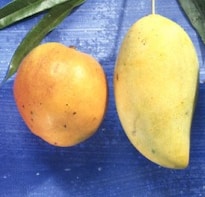Why mangoes are good for you
Mangoes contain a store of phenolic and carotenoid compounds (gallotannins, alpha-carotene, beta-cryptoxanthin and more) that seem to offer some protection against several types of cancer. Vitamin A and beta-carotene in mango can boost your eye health, while vitamin B6 helps control homocysteine in the blood. High levels of this amino acid are associated with increased risk of heart disease and stroke. The soluble fibre in mangoes slows down the release of sugar into your blood, but mangoes are sweet, so not the best fruit choice for slimmers.Where to buy and what to pay
Indian and Pakistani mangoes brighten greengrocers' displays and urban markets. The price starts high, at around £1.99 each, then drops as the season gets into its swing. Expect to pay £6 for boxes of six or £10 for 12. Bulk buy and don't worry about getting through them; that's never a problem.Joanna Blythman is the author of What To Eat (Fourth Estate, £9.99). To order a copy for £7.99 with free UK p&p, go to guardianbookshop.co.ukAdvertisement
Cardamom labneh with mango and rosewater
You'll need a new J-cloth or clean muslin to make this labneh, a fresh cheese made by straining yoghurt, preferably overnight. It has many sweet and savoury uses and makes a good fresh accompaniment to fruit. Serves 4½ tbsp soft brown sugar8 cardamom pods, deseeded and crushed to a powder
Zest and juice of ½ lime
300g Greek yoghurt
1 tbsp honey
1 tsp rosewater
2 mangoes
30g shelled pistachios, roughly chopped
Advertisement
Advertisement
Photograph: Bodo Schieren/Getty Images/Picture Press RM
Advertisement
For the latest food news, health tips and recipes, like us on Facebook or follow us on Twitter and YouTube.
Advertisement
Tags:
